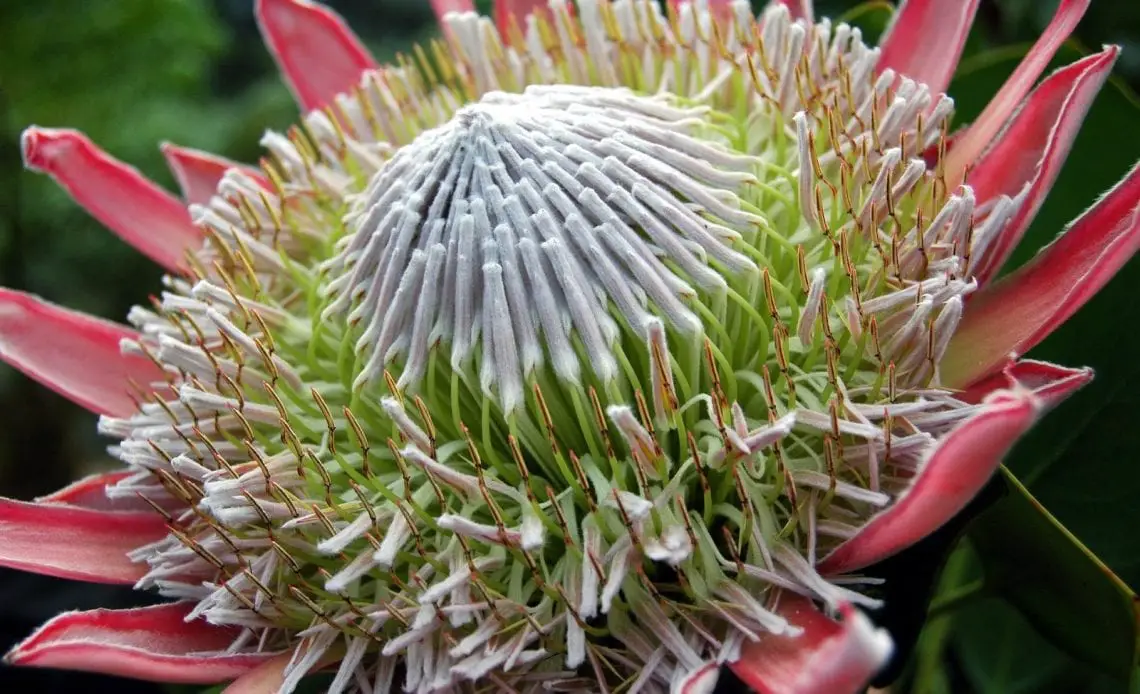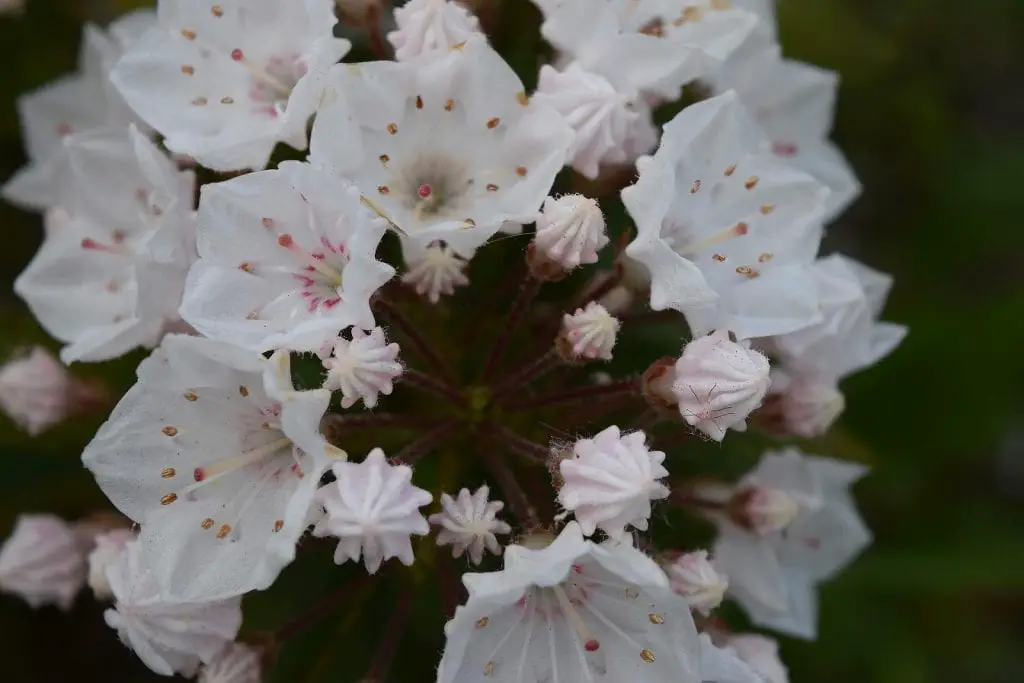
St. Therese of Lisieux once said: ‘“If every tiny flower wanted to be a rose, spring would lose its loveliness.” Luckily, the world is abundant in flowers of every shape, color and fragrance. Many flowers are so extraordinary and unique, that even the most cherished rose may stand in awe of them. Here is a list of some interesting flowers that start with K.
1) Kapa-Kapa: The Philippine Rainforest Flower Which Mesmerized a King
Botanical name: Medinilla magnifica
Common names: Kapa-Kapa, showy Medinilla, Philippine Orchid, Rose Grape, Chandelier Tree, Pink Lantern
Endemic to the Philippines, Kapa-Kapa or Medinilla magnifica is a magnificent hanging flower. Kapa-Kapa is mostly pink, with shades ranging from pale to coral red. Multiple small flowers are clustered within long panicles and enveloped in large, pink bract leaves. Hanging on their prominent stems, the Kapa-Kapa flowers resemble trusses of grapes.
Kapa-Kapa is an epiphyte, a flowering “air plant” that supports itself on the rainforest trees of Luzon, Mindoro, Negros and Panay. With the clearing of the rainforest, Kapa-Kapa is nowadays rarely found in its natural habitat. It is cultivated in botanical gardens around the world as a highly popular and sought-after flower.
Kapa-Kapa is a word in Tagalog, a Central Philippine language. The flower was introduced to the Western world in the mid-nineteenth century by the English collector J.H.Veitch. To the eye of the British horticulturalists, the distinguishing beauty of this tropical flower was enchanting and irresistible. They incentivized its trade by bestowing a grand prize on it. Kapa-Kapa has been grown in the European royal conservatories. Baudouin, the King of the Belgians, was so captivated by the flower’s beauty, that he even printed it on a Belgian banknote.
2) King Protea: The Gigantic South African Flower With a 300-Million-Year-Old Genome
Botanical name: Protea cynaroides
Common names: King Protea, King Sugar Bush, Giant Protea, Honeypot, Cape Artichoke Flower
King Protea is a truly royal flower of gigantic size. Appreciated for its regal appearance, King Protea is described as a huge, bold and magnificent flower. Its dimensions range between 15 and 30 cm. The colorful, crown-like head is, in fact, a composite flower. Its center, shaped like a dome, is a large cluster of silvery-white smaller flowers. The ‘crown’ consists of pointed bract petals in shades of pink, red and crimson.
King Protea is a national flower of South Africa. Its natural habitat is the coast on the Cape of Good Hope, along hillsides. The flower is immensely resilient to drought and adaptable to harsh conditions. In the past, this tropical flower grew abundantly in the wild, but today it is mostly cultivated. It is found across the world, in parks and botanical gardens. When cultivated, this ornamental evergreen shrub requires good drainage and exposure to sun. Various insects and small birds take part in the flower pollination, adding a special charm to the garden.
The origin of this flower’s name is the word protean, which means “that which can change its shape.” The Greek god Proteus was a master of shape-shifting. Since there are at least 80 different varieties of King Protea, its name is an obvious reference to the diverse range of colors and shapes within the genus. The flower was named by Carl Linnaeus, the 18th-century “father of modern taxonomy.” Botanists classify Proteas among the oldest flowering plants and believe that they are dating back 300 million years. Due to its size, cultural and scientific significance, King Protea can easily be considered the most impressive among the interesting flowers that start with K.
3) Kahili Ginger: The Fragrant Perennial Beauty of the Himalayas
Botanical name: Hedychium gardnerianum
Common names: Kahili Ginger, Kahila Garland-Lily, Ginger Lily, Wild Kahili Ginger, Fragrant Ginger Lily, Himalayan Ginger, Sun Kewaraa, Pankhaa Phool, Yellow Ginger
When in bloom, the Kahili Ginger flower has so many features to be admired for. The bright-yellow flowers with prominent, extra-long red stamens are nestled in bracts and clustered along a green raceme. A single spike can be up to 45 cm long and can contain as many as 50 flowers. The flower has an unforgettable strong and sweet fragrance.
Kahili Ginger is native to the Himalayan regions of India, Nepal and Bhutan, thriving at an altitude of 1900 m. This ornamental plant was introduced to Hawaii in the early nineteenth century. Kahili Ginger is another flower which has been associated with regality. Kāhili is the name of a feather standard, an important ceremonial object of Ancient Hawaiian regalia. Kahili Flower resembles the arrangement of bird feathers on the top of the royal staff.
In spite of its beauty, today, this perennial plant has the unflattering reputation of being on the list of the top 100 worst invasive alien species in the world. It has spread rapidly in many countries, including Hawaii, Cook Islands, Jamaica, Micronesia, New Zealand, Australia and South Africa. Labeled a weed, this flower has impacted the integrity of the native ecosystems. Its cultivation in gardens and parks around the world is governed by the general bio-security obligation of the Biosecurity Act 2014.

4) Knautia Macedonica: The Crimson European Beauty
Botanical name: Knautia macedonica
Common names: Macedonian Scabious, Crimson Scabiosus, Scabiosa Rumelica, Trichera macedonica
The flower has a striking color: people describe it as raspberry-red, dark pink, wine-red, crimson-red, burgundy or magenta. The plant features striking pincushion blooms on slender, wiry stems. The globular flower-heads have a diameter of 3-4 cm, and they look like mini rosettes. Each flower-head is, in fact, an involucre of numerous tiny little flowers.
As a garden flower, Knautia Macedonica is cherished for its wild, sylvan-like beauty and for its ability to attract butterflies, birds and other pollinators. This hard, reliable and resilient bushy perennial sometimes sprawls. It is a low-growing and long-blooming plant that thrives mainly on well-drained soil and in full sun.
This clump-forming plant is native to the Balkans and Central Europe, where it blooms from July to September. Its name carries a geographical reference to Macedonia, and a historical reference to Christoph Knaut, a seventeenth-century German botanist.
5) Kobus Magnolia: A White Cloud of Airy Blossoms
Botanical name: Magnolia kobus
Common names: Kobushi Magnolia, Mokryeon, Northern Japanese magnolia
Kobus Magnolia is a perennial, deciduous small tree or shrub. Blossoming profusely in the spring, the tree is densely covered in creamy white to silky gray, mildly fragrant flowers. The flowers bloom on bare twigs, well before the opening of the leaves. When fully opened, the cups or goblet-shaped flowers are 10 cm wide, each having 6 to 9 petal-like tepals. At their base, the delicate white flowers are sometimes tainted in light pink, purple or yellow. In springtime, a well-developed tree, completely covered in white blossoms that emanate a pleasant fragrance, makes an impression that is almost ethereal.
Kobus Magnolia is native to the forests in Japan and Korea. In Japanese, kobushi means fist, and alludes to the shape of the flower bud. In is said that in the past, the blooming of Kobus Magnolia was nature’s way of announcing to the Japanese farmers that it was time to sow their fields. Today, this ornamental tree is commonly available and decorates many parks, avenues and gardens around the world. It was introduced to Europe in the late eighteenth century.
6) Kalmia: The Flower That Pranks With the Bees
Botanical name: Kalmia latifolia
Common names: Mountain Laurel, Spoonwood, Calico Bush
Kalmia flowers, each 2-3 cm wide, form beautiful large clusters. The flowers are five-lobed and in the shape of a bell or a bowl. The inside of these pinkish to white flowers is dotted with striking pink or purple marks. The stamens seem to play a curious game with its pollinators — the moment they are touched, their spring-like mechanism sprays pollen all over the insect’s body.
Kalmia is native to North America and the West Indies. The flower was named after the Swedish botanist Peter Kalm. He was a student of Carolus Linnaeus, and he frequently traveled across the forests of America and Canada. The flower, as well as most parts of this plant, are poisonous to humans and many animals. Kalmia is a traditional medicinal plant used by some Cherokees as a disinfectant, an analgesic, and an ointment for skin diseases. Interestingly, the wooden part of the evergreen shrub has been used in the production of briar tobacco pipes.
7) Kniphofia rooperi: The Fiery Torch
Botanical name: Kniphofia rooperi
Common names: Red Hot Poker, Torch Lily, Tritoma
Among the interesting flowers that start with K is Kniphofia rooperi, often called the Torch Lily. One often asks what is in the name? In the case of Kniphofia rooperi, popularly known as the Red Hot Poker flower, the name is quite an accurate descriptor of its extravagant appearance. Resembling a fiery torch, this plant has an egg-shaped and bi-colored flower of radiant red and yellow, which grows on a meter-tall, erect stalk. The squatty flower-head is, in fact, a raceme of densely-arranged, dangling tubular flowers.The flower’s native habitats are the coastal marshes of the Eastern Cape of South Africa. This flower was named after two famous historical persons. Kniforia owes its name to J.H. Kniphot, an eighteenth-century professor of medicine who authored “Botanica in originali,” an impressive folio of plant illustrations. Rooperi comes from the name of the nineteenth-century Captain Edward Rooper, who served in South Africa. An avid artist, Captain Rooper made this flower famous in England through his flower paintings.
